Isometric Exercises are a great way to build mobility, stability and strength in your lower body.
While most people include dynamic and static stretches in their workout routine, they often forget about the importance of Isometric Moves to developing mobility and even flexibility.
And Isometric Exercises are key.
Dynamic and static stretches do improve your flexibility and mobility; however, they don’t at the same time strengthen and build stability through that new range of motion.
Then when we go lift, even after doing the stretching, we often don’t work through the increased range of motion, which simply means we tighten everything back up only to have to stretch out and loosen up again.
By including Isometrics, you not only improve your flexibility and mobility, but you also work and strengthen through the new range of motion to help you keep the increased range of motion.
And, by doing Isometrics, you can learn to activate and feel the correct muscles working during the movements so that, when you go to lift weights, the correct muscles are being recruited through a full range of motion!
Below are 15 Leg Isometric Exercises you should include in your workout routine to not only improve your hip mobility and the flexibility of your legs, but also strengthen and build stability.
15 Leg Isometric Exercises
With these 20 Leg Isometric Exercises, you can mobilize your hips, stretch out your legs, activate your glutes and work your quads and hamstrings. You can also even improve your balance and core strength.
Split Squat Hold – The Split Squat Hold is a great lunge isometric to stretch your hip flexors, activate your glutes and work your quads. It will also improve your balance and core strength.
And if you struggle to get deeper in your lunges, this is a great way to increase your range of motion.

To do the Split Squat Hold, step one foot forward into a wide lunge stance. Keeping your chest up nice and tall, balance on your front foot and the ball of your back foot.
Then drop your back knee down toward the ground. Bend your front knee as close to 90 degrees as possible as you sink down as low as you can in the lunge. Try to keep your back knee just hovering over the ground if possible.
Make sure to keep your front heel down and your weight centered as you hold at the bottom of the Split Squat.
Keep your chest up nice and tall as you hold and make sure to squeeze the glute of the leg that is back to extend the hip and make sure your low back isn’t arching to keep your torso up nice and tall.
Chair Pose with Glute Stretch – Improve your balance, strengthen your core, work your legs individually to correct imbalances and stretch out your glutes and hips with this Chair Pose with Glute Stretch move.
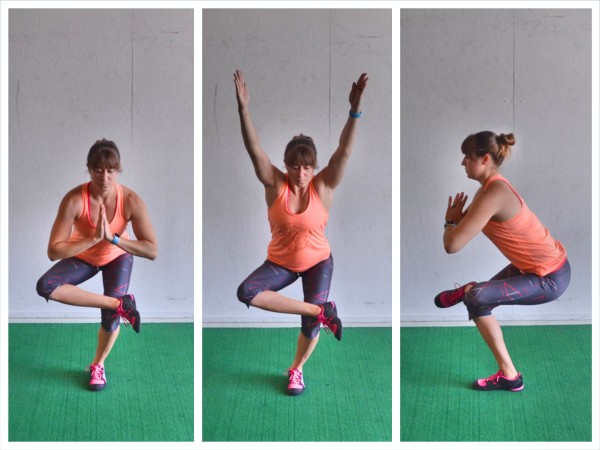
To do the Chair Pose with Glute Stretch, start standing then cross one ankle over the other leg right above your knee.
Sit your butt back and sink into a squat with your one leg crossed over. From here you can keep your hands on your legs, bring them into prayer pose or reach them up overhead.
Make sure to sit your butt back as you squat and keep the knee of the leg crossed over open. Hold and breathe and keep your chest up as you hold the squat.
Scissor Hamstring Stretch – Another great Isometric move for your legs is the Scissor Hamstring Stretch because it stretches not only your hamstrings but also your calves to improve your ankle and hip mobility. It also requires a lot of stability to balance as you hold.
However, this is a more challenging move and beginners may want to have a yoga block or even a wall in front of them to place their hands on since they may not be able to reach the ground.

To do the Scissor Hamstring Stretch, step one foot forward into a nice wide Split Stance. Drive the heel of the back foot down as your front foot is flat on the ground.
Keeping both legs straight, hinge over placing your hands on the ground. Push your butt back as you hinge over.
Breathe and relax into the stretch and try to sink deeper into it as you relax.
Make sure to keep both legs straight even if it means you have to place your hands up on something instead of on the ground.
Extended Triangle – The Extended Triangle is a great variation of the Scissor Hamstring Stretch that opens up your hips and groin while stretching your hamstrings and calves. And because of the rotation with your upper body, it also opens up your chest and back as well.
Just like with the Scissor Hamstring Stretch, beginners may not be able to reach the ground. With this stretch, you can place your hand on your shin or even on your foot if you don’t have a block or something else to use.
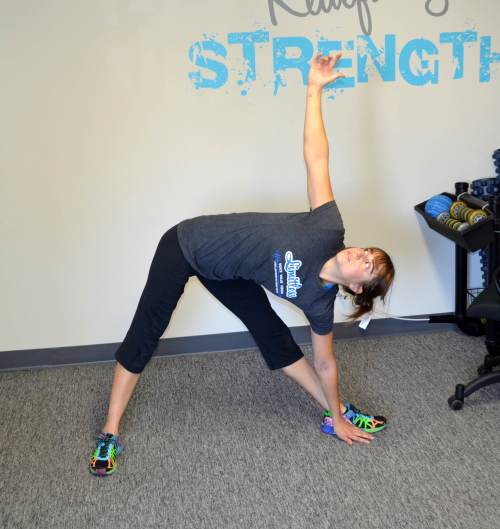
To do the Extended Triangle Pose, set up in a wide stance, stepping one foot forward (with your feet about 4 feet apart). Turn your back toe out while your front foot should be pointing straight ahead. You want your feet to be almost perpendicular although you back toe can be slightly forward. Make sure that your front foot is about at the instep of your back foot if you look back from your front heel to your back foot.
Then push your butt back and hinge over at the hips, reaching the same hand as the leg that is forward down to the ground. Make sure to keep your legs straight as you hinge. If your legs start to bend, do not reach lower or make sure you are pushing your butt back. You may also find you need to bring your back foot in so your stance isn’t quite as wide to help you keep your legs straight.
Place your hand on the ground at the instep of your foot. If you can’t reach the ground, you can also place your hand on a block, your foot, your shin or your ankle to help make sure you keep your legs straight.
Extend your opposite arm up toward the ceiling, opening your chest up toward the ceiling. If you can’t really open your chest up toward the ceiling, you may want to place your hand up higher on your leg or on a block. You can then keep looking at the ground to help you balance or look up toward the ceiling to make the move harder.
Twisting Extended Triangle – If the outside of your legs and hips are super tight and you suffer from hip, knee or ankle pain, this is another great variation of the Scissor Hamstring Stretch to try. This move will also stretch your back and open up your chest while improving your balance.
This is a more challenging Isometric and, again, you may need a block to place your hand up on.

To do the Twisting Extended Triangle, you will set up in a wide stance, although probably not quite as wide as with the Extended Triangle. Both feet will be pointing straight ahead with the back toe only slightly turned out.
Then keeping your legs straight, hinge at the hips as you push your butt back, dropping the opposite hand from the leg forward down to the ground at about your instep.
Reach your other hand up toward the ceiling and rotate your chest open toward the front leg.
If you can’t reach the ground and keep your legs straight, you will want to place your hand up on a block or chair. Try to really open your chest up toward the ceiling.
Keep your eyes on the ground to help with balance.
Twisting Half-Kneeling Hip and Quad Stretch – Because most of us sit all day hunched over a computer screen, our hips get tight and that throws our lumbo-pelvic-hip-complex out of alignment. This Twisting Half-Kneeling Hip and Quad Stretch, releases your hips, glutes and eve your back to open you up after sitting at a desk all day.
This Isometric requires more flexibility so if you are less flexible, you may need a towel to help you grab your back foot and pull your heel in.
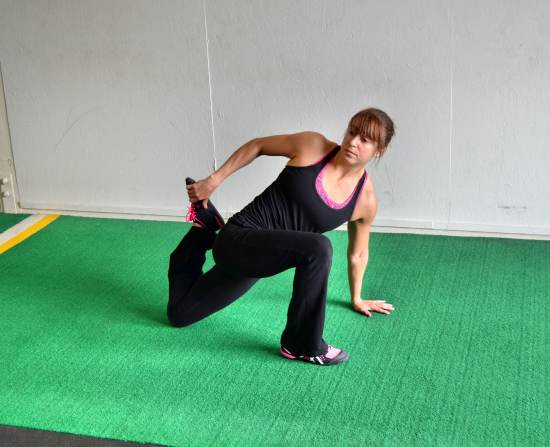
To do the Twisting Half-Kneeling Hip and Quad Stretch, set up in a half kneeling position with your right leg forward. Then place your left hand on the ground under your shoulder and in line with your right foot.
Reach back with your right hand and grab your left foot. Pull your foot in toward your butt as you drive your hip forward and lean forward a bit. Feel a stretch down your hip and quad.
As you press your hip forward, rotate your chest open toward your front leg. You may also feel a stretch through your spine and down the outside of that front leg. Hold here and breathe as you relax deeper into the stretch. You can also open your back knee outward to stretch into your adductor or rotate your knee inward to hit your TFL.
Beginners may need a towel or stretch strap to help them do this stretch as it requires more flexibility to reach around and grab the leg with the rotation.
Make sure that as you do this stretch, you squeeze the glute of the leg that is back so that you are actually extending at the hip and not hyperextending your low back.
Wall Sit – The Wall Sit is a very traditional Isometric Exercise but one of the best especially if you’ve ever had knee pain. It is a great way to strengthen your legs and especially your quads.
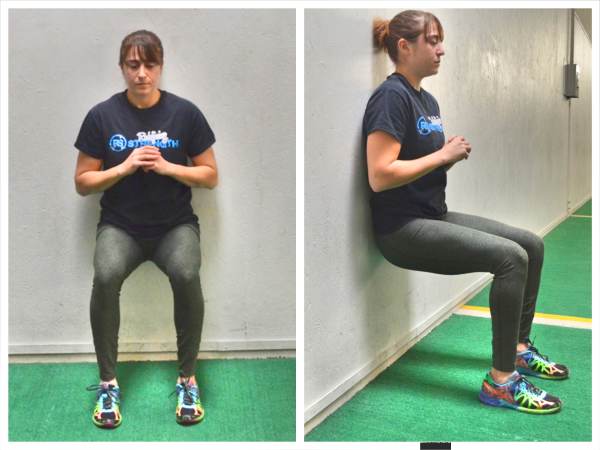
To do the Wall Sit, stand with your back to a wall and your feet about hip-width apart. Then sink down into a squat and press your back into the wall behind you.
When you sink into the squat, try to get your quads parallel to the ground and make sure your ankles are aligned under your knees. Hold there and drive your back into the wall.
If you start to feel this in your low back, try engaging your core with a pelvic tilt. Press your low back into the wall. Make sure you aren’t rocking forward onto your toes, but instead are driving through your entire foot.
To make this move easier, don’t sink as low in the squat or move your feet out just a bit from the wall. Do not let your ankles get too far out in front of your knees though.
Warrior I – Warrior I is a great stance to strengthen your legs as you improve your hip mobility. This Isometric will stretch your hips, groin and even your abs and ankles. It will work your quads and activate your glutes. If you also have Sciatica, this is a great move to include.
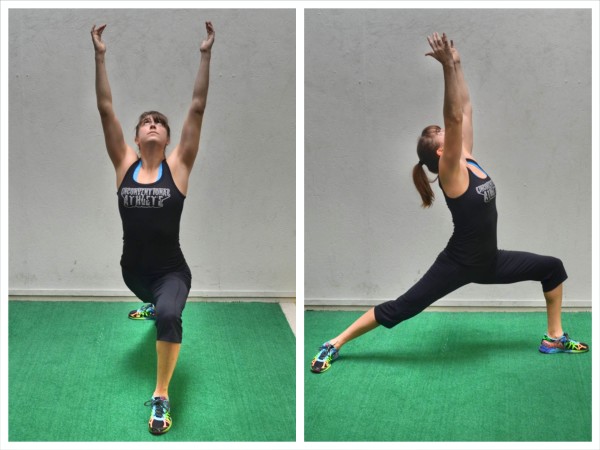
To do Warrior I, set up in a nice wide stance with one foot forward and one foot back. Turn the back toe out so your feet are about perpendicular with your front foot lined up with about the instep of your back foot when you turn it out.
Bend your front knee and sink down into a lunge, keeping the back leg straight and the front heel firmly planted. Rotate your hips to face forward as you reach your hands up overhead. Squeeze the glute of the back leg to make sure that you are extending through your hip. Also, do not let the front knee cave in as you hold.
Try to get your front knee bent as close to 90 degrees as possible and your quad parallel to the ground. Beginners may not be able to sink as deep. You may find you need to step your front foot forward a bit more to sit comfortably in the lunge and keep the front heel down.
The lower you sink in the lunge, the harder the move will be. Again, do not let your front knee cave inward. Make sure to squeeze your glutes and keep the knee in line with your hip and your ankle.
Breathe and relax into the lunge. Make sure you keep both feet flat on the ground and your back knee straight.
As you reach up, do not hyperextend your low back. Make sure to squeeze your glutes and stretch through your hips.
Warrior II – A variation of Warrior I, Warrior II is a great way to strengthen your legs and external rotators while also stretching your adductors and even your calves. And because you are holding your arms out, even your shoulders are working!
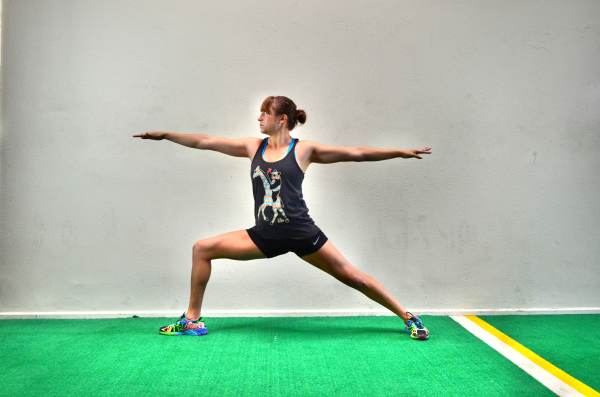
To do the Warrior II, step forward into a nice wide stance, keeping your front foot pointing straight ahead while you turn the back toe out so your feet are about perpendicular. Line up the back of your front heel with the instep of your back foot.
Then sink down into a lunge, bending your front knee while keeping the back leg straight. Try to get your front knee bent to 90 degrees and your quad parallel to the ground. Beginners may not be able to sink as low. You may also find you need to step your front foot forward a bit more to sit comfortably in the lunge and keep the front heel down and your front knee over your ankle.
Do not let your front knee cave in or your back leg bend. Squeeze your glutes and keep your front knee in line with your hip and your ankle. Squeezing your glutes will also help open up your hips.
Also make sure that while you hold the low lunge, your back foot stays flat on the ground. Do not rock in on your back foot as you hold.
While holding the low lunge, open your arms out at shoulder height, reaching one forward over the front leg and the other back over the back leg. Keep the chest open and do not lean forward. Keep your weight centered in the lunge.
Warrior III – If you want to improve your balance and strengthen your foot, calf, hamstring and glute while also increasing your leg flexibility and hip mobility, then you need to do the Warrior III. This is a great move to activate your glutes and open everything up before doing a hinge or leg workout.
This is also a must do move if you’ve had foot, ankle, knee or hip pain or problems.
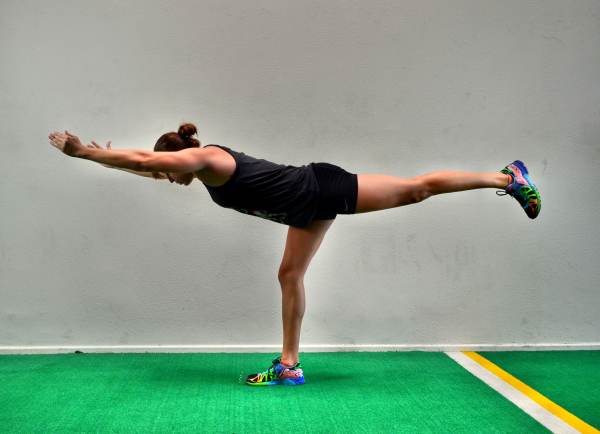
To do the Warrior III Isometric, start standing tall with your feet together. Then shift your weight so you are balancing on one foot.
Hinging at the hips, lean your torso forward as you push your butt back and lift your back leg straight toward the wall behind you. Pretend you are driving the foot of the lifted leg straight back into the wall behind you as you reach your head toward the wall in front of you.
Maintain a nice straight line from your head to your raised heel, making sure to keep your back flat and your core tight as you hold this hinged over position. You can then reach your hands overhead in front of you, out to your sides or back toward your heels.
As you hold in this position and feel your foot working to grip the ground, try to straighten your standing leg as much as possible to work on improving your mobility while your glutes and core work to keep you balanced. Also make sure your hips don’t rotate open. Squeeze the glute of the lifted leg to keep your hips level and square to the ground.
Do not let your back round or your other foot touch down as you hold. Only straighten your standing leg if you can balance and maintain a straight line with your body.
Beginners may need to reach back toward their foot instead of out in front of them or they may want to use a wall behind them to help them balance. Stand with a wall behind you and when you hinge over have the lifted foot lightly touch the wall behind you to help you balance.
Standing Splits – The Standing Splits is a great way to stretch your calves, hamstrings, hips, glutes and quads. It is also a great Isometric Move to improve your balance and strengthen your entire leg and glute.
Beginners may need to place their hands up on a block or chair and may not be able to touch the ground.
To do the Standing Splits, start in the Warrior III position, balanced on one leg. Then hinge over further, dropping your hands down to the ground as you raise your raised leg up higher toward the ceiling.
Try to straighten your standing leg as much as you can as you drive your nose back toward your knee and lift your raised leg up toward the ceiling. Breathe and relax into the stretch and try to bring your head toward your standing leg as you reach your raised leg up to do a standing split. (right)
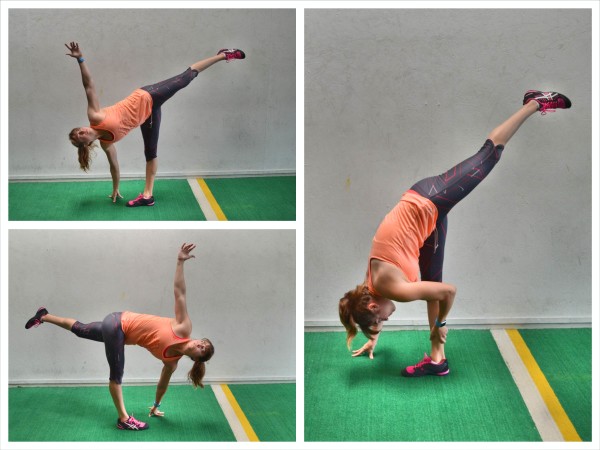
Half Moon – The Half Moon is another great Leg Isometric Exercise to work on your balance and leg strength while improving your hip mobility. This move will stretch your groin, hamstrings, glutes, hips and calves as well as your chest and spine. This is also a great way to activate your glutes and strengthen your core.
To do Half Moon, from the Standing Splits position, lift your opposite hand from your standing leg up toward the ceiling, keeping the same hand as the standing leg down on the ground. Rotate your chest and hips open and raise your raised leg up toward the ceiling.. Try to straighten your standing leg as much as possible as you hold.
If you struggle to keep your hand on the ground and rotate open, place your hand up on a block or stack of books. Breathe and try to straighten your standing leg as you raise your raised leg up toward the ceiling and rotate open. (top left)
Twisting Half Moon – The Twisting Half Moon is a great way to stretch the outside of your hip as well as your glutes, hamstrings, calves, and groin. It also improves your balance, hip mobility and core and leg strength. And because the pose requires you to twist, it is a great way to stretch out your back and prevent and alleviate low back pain.
To do the Twisting Half Moon, from the Standing Splits position, rotate toward your standing leg, keeping the opposite hand from the standing leg down on the ground as you reach the same hand as the standing leg up toward the ceiling. Rotate your chest toward your standing leg and open toward the ceiling. Don’t be afraid to drop the hip of the raised leg down a bit so you feel a stretch outside the hip of your standing leg.
Breathe and try to rotate toward your standing leg more as you keep the standing leg as straight as possible. If you struggle to rotate and keep your hand on the ground, you can place your hand up on a stack of books or on a block. (bottom left)
Crescent – The Crescent Isometric Move is a great way to stretch your hips and quads while activating your glutes and improving your core strength and balance.

To do Crescent, step one foot forward into a wide stance and bend the front knee to sink into a deep lunge while keeping the back leg out straight. Your front heel should stay down while your back heel will be up. Make sure you are really sitting back into your front heel as you are driving your back heel down toward the ground to straighten your back leg.
Hold in this low lunge and lift your hands up and back overhead. Keep your front heel down as you sit back into the lunge. If your front heel is coming up, you may want to step your front foot forward a bit more.
As you hold the lunge, feel a nice stretch down your back hip and quad. Really squeeze your glutes to press your back hip forward and to keep your front knee from caving in. Make sure that you are extending your hips and not arching your low back as you reach overhead.
Also, make sure your low back isn’t arching as you reach back overhead. By squeezing your back glute, you will make sure your hip is stretching.
Glute Bridge Hold – If you sit at a desk all day, you need to include the Glute Bridge Hold in your workout routine. This move stretches your hips and activates your glutes to alleviate and prevent low back and hip pain. It will also help strengthen and tone your glutes so you can lift more and have great looking legs!

To do the Glute Bridge Hold, bend your knees and place your feet flat on the ground just close enough that you can graze your heels with your fingertips when you stretch your arms down by your side. Your feet should be about hip-width apart. You can change up how far your heels are from your butt. You can place your heels farther from your butt, just make sure that you feel your glutes working to lift and not just your hamstrings or your low back.
Then bend your elbows to 90 degrees so that only your upper arms are on the ground. Bridge up, driving through your heels and your upper back and arms. Lift your glutes up off the ground and drive your hips up as high as possible. Squeeze your glutes hard and keep your belly button drawn in so you don’t hyperextend your back.
Do not push backward off your heels. Make sure you are driving straight up almost as if driving your knees forward over your toes. Also, make sure that your knees aren’t caving in or falling open.
Squeeze your glutes and hold at the top. Concentrate on feeling your glutes work. Don’t just go through the motions.
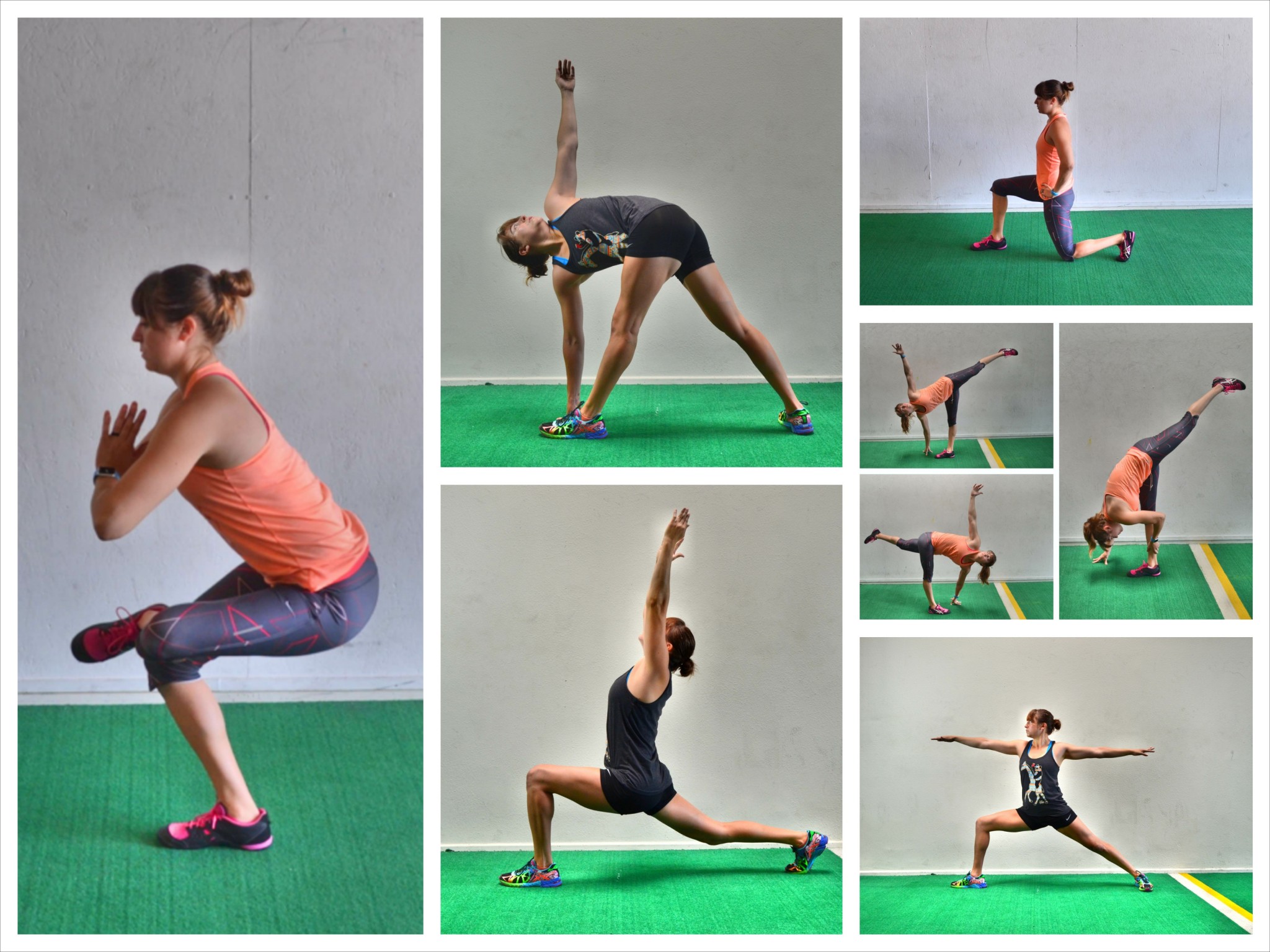


How long for each stretch please
Hi John.
Depending on the stretch and what you hope to accomplish, I recommend anywhere from 20 seconds to 45 seconds. Some of them you can even hold and flow through for 1 minute. If I set a timer for 1 minute, I may flow from Warrior III, to Standing Splits, to Half Moon or even Twisting Half Moon. I may do all of them in the minute or maybe only 1 or 2. The next round I may then do the ones I didn’t hit or focus on the ones that address where I’m tightest.
It is important to focus on the moves that address your specific areas of tightness.
Here is also a sample of a basic Isometric Workout I use:
https://redefiningstrength.com/pain-be-gone-isometric-workout/
Great and innovative routines! Thank you for the informative article!
I am researching/ self-experimenting with ways to increase overall leg endurance in long descents during ultra-marathons and find isometric contractions like these to be really helpful.
Nice to find something other than just wall-sits!
Thank you! Oh yes some variety is key! You may also want to think about lots of glute activation for knee and hip health. Plus glute activation can help with powering your gait properly. And hopefully you are foam rolling too! Good luck with your ultras! – Cori
Where in the workout do you put these exercises?
I would use them as a warm up or even as part of the workout like this – https://redefiningstrength.com/strength-isometric-workout/
Hi How would you differentiate between a static stretch and an isometric exercise ? Or how would you describe it to your group class on the difference? thank you , Jacq @Singapore
Hi Jacq. So a static stretch is an isometric, but not all isometrics are static stretches. Isometric refers to the part of the muscles contraction aka when the muscle length and joint angle don’t change and tension is held. So you could hold a bicep curl and do an isometric contraction and that wouldn’t be a static stretch at all. Does that make sense?
I have osteoarthritis in my knee,are all these safe for my situation?
While seeing a physio to address your specific needs is good, generally Isometrics are good place to start. Some mini band moves may also be good. But you do want to get moving as it does help long term generally with osteoarthritis.